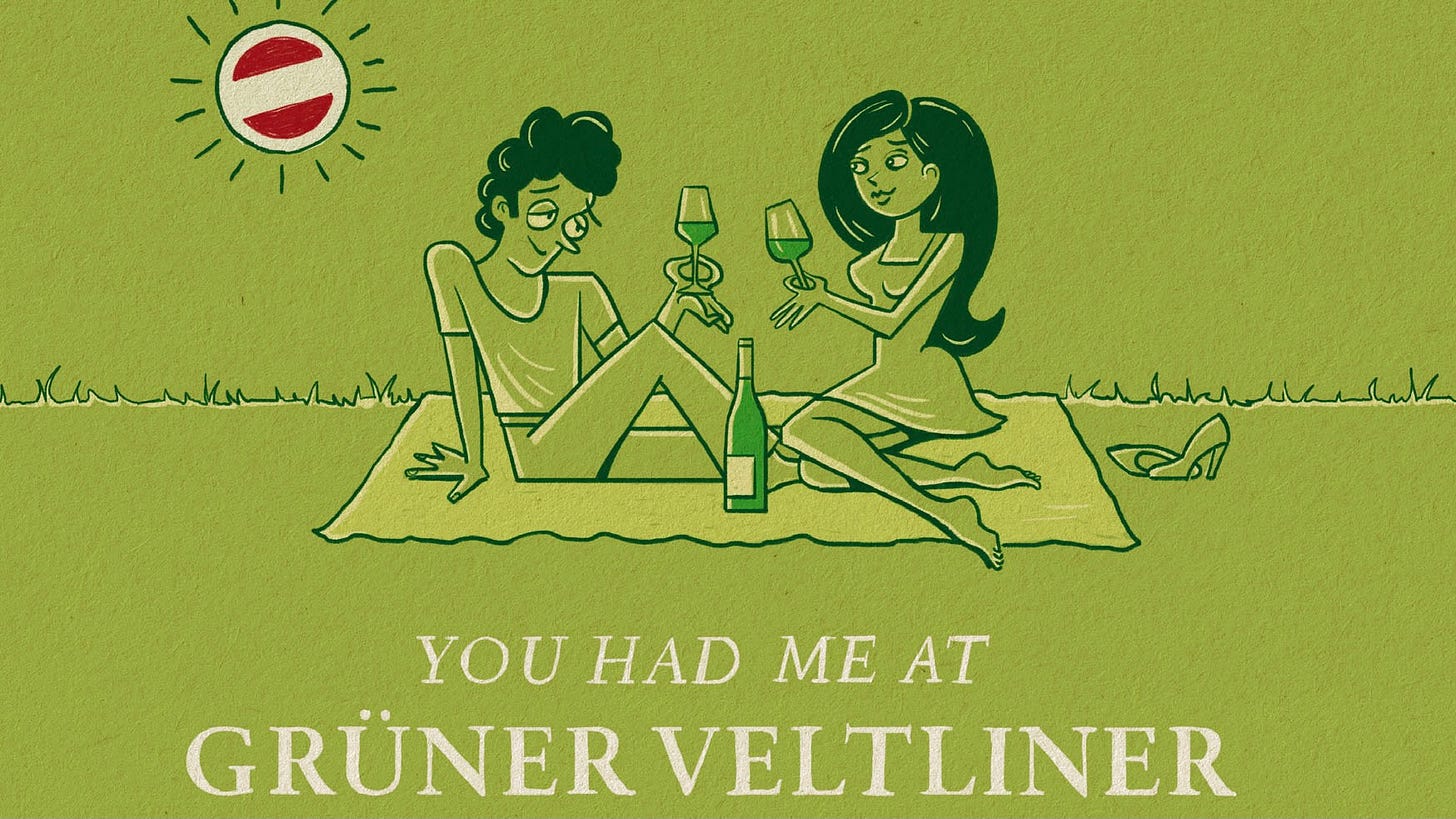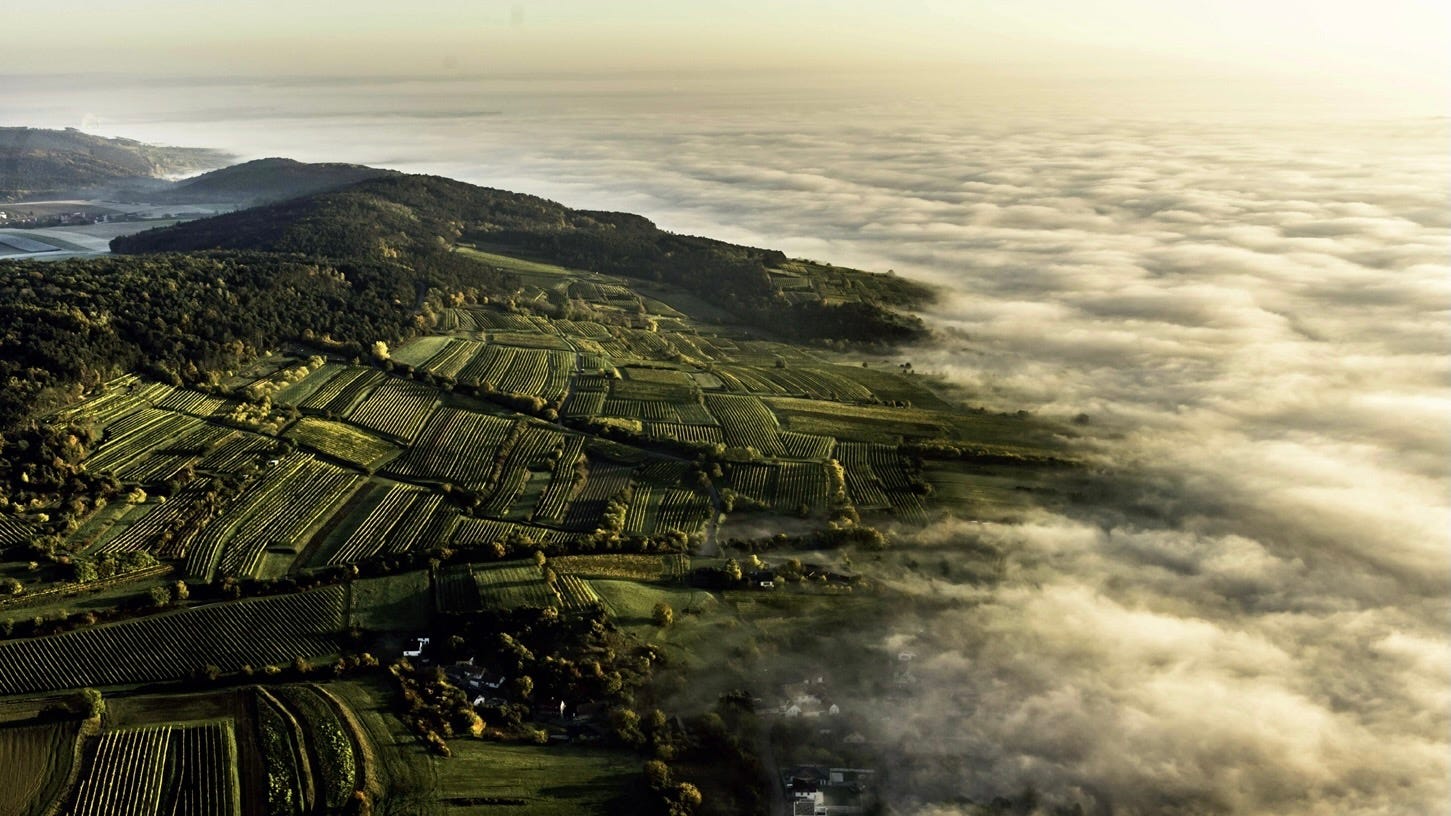There's No Use Crying Over White Burgundy. Just Drink Grüner Veltliner.
As prices on French chardonnay rise into the stratosphere, a certain ageworthy Austrian white is looking better and better.
Anyone who knows me knows that I never shut up about Austrian wines. I adore Austria and its wines. In this newsletter, I’ve declared roter veltliner (even more obscure than grüner) to be the wine of the coming vibe shift. I’ve paired little-known varieties such as rotgipfler and zierfandler with roasted chestnuts during the holidays. And I’ve proselytized about the virtues of gemischter satz field blends and open-faced sandwiches.
But my most controversial wine take (and possibly most unhinged) is that everyone should dump hyper-expensive white Burgundy and drink Austrian grüner veltliner instead. Yes, I said it. I know it sounds crazy. I have my reasons. But just take a moment and let the notion wash over you, while you gaze at this beautiful image of the vineyards of Kamptal (one of Lower Austria’s prime regions along the Danube).
Now, I’m not saying Austrian grüner veltliner is necessarily better than white Burgundy (although plenty of times it is). The fact of the matter is, most drinkers are not going to be able to afford good Côte de Beaune or Côte Chalonnaise or even Chablis anymore. Wine people have been predicting this for a number of years. “Is it time for Burgundy lovers to panic? Are the prices of these most exquisite and expressive wines about to spiral into the stratosphere, propelled by a burgeoning generation of Burgundy fans from China?” asked the New York Times in 2012.
Fast forward a decade later, and the devastating Burgundy harvest of 2021, with extreme weather events like hail, frost, and drought. Chardonnay was affected much worse than pinot noir. Many white wine producers lost more around 80 percent of their usual yield. This is not the first dicey harvest — climate change is making things more difficult every year. So, with historically low volume and thirsty demand, prices inevitably skyrocket. “French white wine prices are surely bound to rise,” said Jancis Robinson (with her signature understatement) in the Financial Times. “Don’t Wait to Buy Burgundy Wines,” said The Drop. And then this from British trade magazine The Buyer:
“I’m concerned about how the average French person can’t buy a bottle Gevrey-Chambertin,” says Vincent Valet of Maison Pierre Bourée et Fils, a domaine founded in Gevrey-Chambertin in 1864. “Wine from Bourgogne is not meant to be a speculative tool. It is meant to be shared. Wine is an emotion, not part of a cheque or a one hundred dollar bill. We are happy to share our wines with as many people as possible, but, please — let’s be civilised about the prices.”
This is, of course, a problem only at the highest end, bottles north of $100. So it’s easy for someone like me to shrug my shoulders. Poor rich people! But the thing is, white Burgundy wasn’t always that expensive. There was a time, not too long ago, when an average wine drinker could splurge once in a while, perhaps at a special restaurant dinner.
So it’s not a surprise that sommeliers, collectors, critics, and other people who care about these things are looking around for alternatives, wines that are so-called Burgundian. Can German riesling be Burgundian? Is Loire chenin blanc from Montlouis or Savennières? I’ve even heard Soave Classico referred to as Burgundian. This chasing of Burgundian-ness has become a fixture of modern wine discourse.
So it’s no surprise that when people speak of top-end grüner veltliner, they reach for the Burgundian adjective. Grüner veltliner can have many flavor profiles. It can sometimes seem like sauvignon blanc and viogner had a love child. It can sometimes veer riesling-like, especially as it ages. But often, at its best, it can follow down the path of chardonnay — but the very good chardonnay, not that oaky, buttery chardonnay that turned you against chardonnay. The Burgundian chardonnay. And it’s true that many grüner veltliner I’ve tasted over the years would fool someone guessing Burgundy in a blind tasting.
Austria producers even modeled their system on Burgundy. Along the Danube, the Österreichische Traditionsweingüter, or ÖTW, is an association of 68 winemakers, formed in 1992, who created a classification system of Lower Austria’s vineyards in the regions of Kamptal, Kremstal, Trainsental, Wagram, Vienna, and Carnuntum (the famed Wachau does its own thing, separately).
Specific vineyards in specific villages are singled out as Erste Lage, or premier cru. A top Kamptal wine, for instance, might label Käferberg or Loisenberg as its premier cru vineyards, in the village of Langenlois, or Heiligenstein in Zöbring, or Lamm and Renner in Kammern. So, yes, things can get just as complicated and confusing as they are with Burgundy!
Still, there’s an easy way to know if you have an Erste Lage wine: It has the umlauted image of 1ÖTW on the label (below). Also, if you see the word “Ried” that means “vineyard.” So the word that follows Ried is probably the vineyard name. If you want to go a little deeper, here is a map of all the Erste Lagen along the Danube.
One thing that makes 1ÖTW grüner veltliner distinctly different than Burgundy is price. I’ve tasted a dozen or so over the past few weeks, whatever I could get my hands on. Most everything was about half the price of top Burgundy, or less. They’re not particularly easy to find. Hopefully we’ll see more of them soon. Austrian white wine imports to the U.S. rose by 23 percent in 2021, so maybe this is the beginning of a new era of availability here.
A final thought: Do not worry about buying slightly older vintages. I know, Americans are wary of “older” whites, but these wines are meant to age. The Bründlmayer Käferberg 1ÖTW Kamptal that I tasted a few weeks ago was from the 2009 vintage, and it was exquisite: rich, dense, curvy, tropical…Burgundian.






Your book (and this column) have motivated me to plan a trip to Austria to learn/drink more. I have searched out and tasted Beck, Josieph, Moric, and some insanely good/cheap zweigelt. These gems are only the beginning of what I hope to discover in country. Any tips on where to visit/stay/time of year are appreciated. Thanks and don't stop !